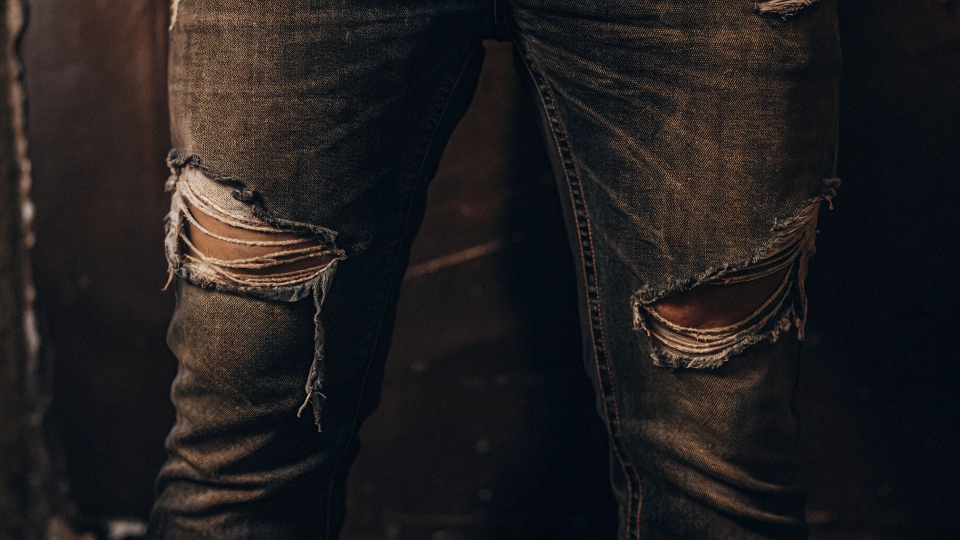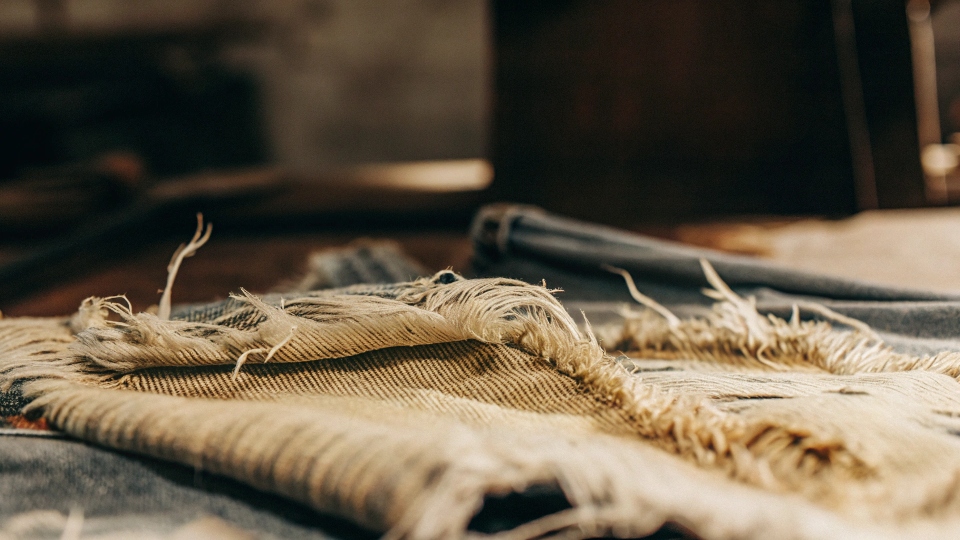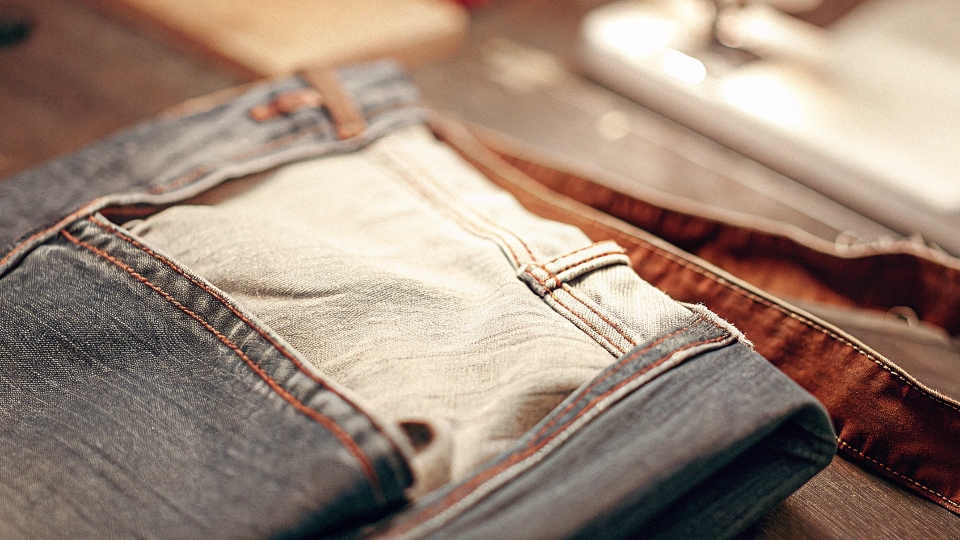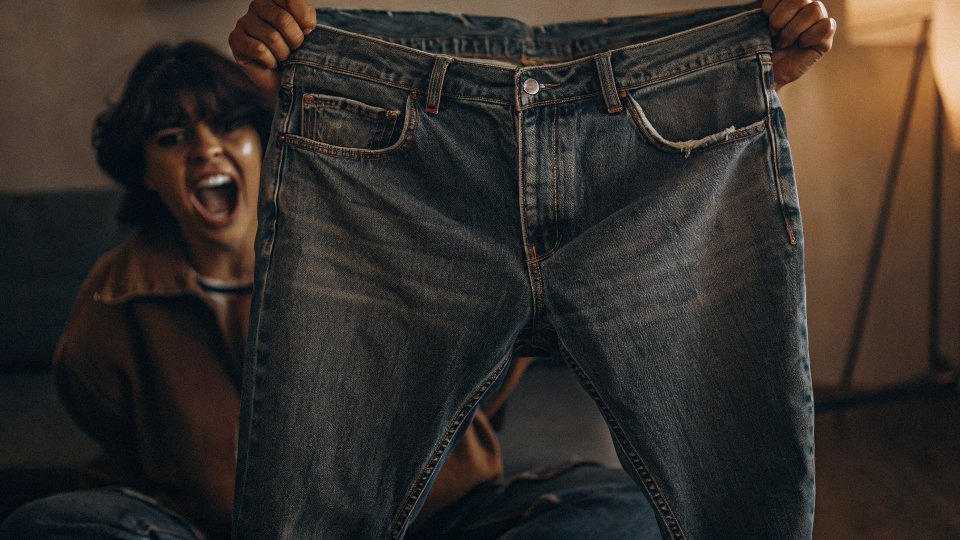You pull on your favorite, perfectly broken-in jeans, and you feel it—a sudden, unwelcome breeze. A blowout in the crotch has turned your beloved jeans into an unwearable rag. It's frustrating, embarrassing, and feels like a total waste of money.
Your jeans rip at the crotch because it is the single highest-stress point on the garment. It endures constant friction from your thighs rubbing together, tension1 from every step and seated position, and moisture, all of which combine to wear down the cotton fibers until they break.
This is, without a doubt, the most common point of failure I see. From my two decades of manufacturing jeans at DiZNEW, I can tell you that a crotch blowout is almost inevitable with frequent wear. It's a battle of physics, and the fabric will eventually lose.
This isn't necessarily a sign of a "bad" pair of jeans; it's a sign of a loved pair of jeans. But knowing exactly why it happens is the first step a designer or a dedicated wearer can take to fight back and extend the life of their denim.
What does it mean when your jeans rip in the crotch?
That tear feels like a personal failure. Did you buy a cheap pair? Are you wearing them wrong? It's an embarrassing wardrobe malfunction2 that makes you question the quality of your favorite brand and your own judgment.
A ripped crotch simply means the fabric has reached its mechanical limit. It's the inevitable result of thousands of abrasive movements and cycles of tension concentrating on one small area. It's a sign of wear, not necessarily a defect in manufacturing or quality.
When a designer like Dean develops a new fit, we obsess over this very area. The crotch is where four separate panels of thick fabric converge into two major seams. This creates a central point that bears the load of almost every movement you make. Walking causes a sawing motion between your legs. Sitting and standing puts tension on the seams.
Even a little bit of sweat can weaken the cotton fibers over time, making them more susceptible to breaking. So, when your jeans rip there, it doesn't mean they were poorly made. It means you've given them a good life, and the material has simply worn out from doing its job.
| Hostile Force | How It Attacks the Crotch |
|---|---|
| Friction | Constant rubbing from thighs while walking or cycling abrades fibers. |
| Tension | Sitting, squatting, and bending pulls at the central seams from all directions. |
| Moisture | Sweat can weaken natural cotton fibers3 and accelerate the damage from friction. |
How can you stop jeans from tearing in the crotch?
You're tired of your favorite jeans dying an early death. It feels wasteful to constantly replace them, and you wish there was a secret to making them last as long as they should.
The best way to stop jeans from tearing is through proactive reinforcement. Before a hole appears, have a tailor stitch a thin patch of denim or soft fabric onto the inside of the crotch. This sacrificial layer will absorb the friction and stress.
This is the number one trick I tell people. Don't wait for the disaster. As soon as you get a new pair of jeans that you plan to wear a lot, invest a few dollars in reinforcing them. Take them to a tailor and ask them to add an internal crotch patch. It's invisible from the outside, but it doubles the life of that high-stress area.
Beyond this, a proper fit is crucial. Jeans that are too tight create constant tension1, while jeans that are too loose can cause excess fabric to bunch up and rub.Finally, give your jeans a rest. Don't wear the same pair every single day.
Letting the cotton fibers rest and recover for a day or two between wears can make a huge difference in their overall lifespan. This simple rotation policy is a classic rule from the world of raw denim enthusiasts, and it works.
Why are jeans so uncomfortable in the crotch?
You slip on a new pair of stiff, raw denim, and it feels like you're wearing a cardboard box. The crotch area, in particular, feels bulky, restrictive, and just plain uncomfortable, making you wonder if you'll ever be able to sit down properly.
Jeans can be uncomfortable in the crotch due to the intersection of thick, heavy-duty seams, the inherent stiffness of new denim fabric, and a fit—particularly the "rise4"—that isn't right for your body shape.
Let's break down the points of discomfort. First, look at the construction. The point right between your legs is where four panels of denim meet. To make this area strong, manufacturers like me use very thick, often flat-felled, seams.
That's a lot of layers of heavy fabric folded over and stitched together, creating a hard, rigid ridge. Second, the fabric itself, especially on a new pair of 100% cotton jeans, is stiff. It hasn't yet softened with washing and wear. Third, and most critically, is the fit.
The "rise" is the measurement from the crotch seam to the top of the waistband. If the rise is too low for your body, it will pull down uncomfortably. If it's too high, it can bunch up. Finding a brand or fit with the perfect rise for your torso is key to all-day comfort.
Why do my Levi's always rip in the crotch?
You've owned several pairs of Levi's, maybe the iconic 501s, and every single one has blown out in the crotch. You start to feel singled out, convinced the brand's quality has dropped or that they are making them to fail.
It's likely not a quality issue with the brand itself, but a mismatch between the specific Levi's fit you're choosing and your body type. A classic, 100% cotton fit on a body with larger thighs or worn by someone who cycles will concentrate all wear in that one spot.
This is a common complaint I hear about many heritage brands, not just Levi's. The issue is often rooted in their most iconic fits, like the 501. These designs were created over a century ago and are made from 100% cotton, which has no stretch.
If you have an athletic build, larger thighs, or a job where you move a lot, the standard dimensions of that specific cut will create intense, targeted friction on your inner thighs. The fabric, having no elastane to give, just takes the abuse until it fails. It's not a conspiracy; it's physics. The solution isn't to blame the brand but to explore a different fit from their range.
Many brands, including Levi's, now offer "Athletic Taper5" fits with more room in the thigh and often a small amount of stretch. This small change can distribute the stress much more evenly and solve the blowout problem entirely.
Conclusion
Crotch blowouts are caused by the combination of friction, tension, and a fit that concentrates stress. The ultimate solution is choosing the right fit and proactively reinforcing the area.
-
Discover how tension contributes to wear and tear in jeans, helping you select better fits. ↩ ↩
-
Find tips to prevent wardrobe malfunctions and keep your jeans looking great. ↩
-
Learn about the role of cotton fibers in jeans and how they impact wear and tear. ↩
-
Understanding the rise measurement can help you find jeans that fit comfortably. ↩
-
Discover how the Athletic Taper fit can solve common issues with traditional jeans. ↩











